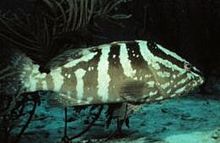Nassau grouper
| Nassau grouper | |
|---|---|
 |
|
| Scientific classification | |
| Kingdom: | Animalia |
| Phylum: | Chordata |
| Class: | Actinopterygii |
| Order: | Perciformes |
| Family: | Serranidae |
| Genus: | Epinephelus |
| Species: | E. striatus |
| Binomial name | |
|
Epinephelus striatus (Bloch, 1792) |
|
The Nassau grouper (Epinephelus striatus) is one of the large number of perciform fishes in the family Serranidae commonly referred to as groupers. It is the most important of the groupers for commercial fishery in the West Indies, but has been endangered by overfishing.
The International Union for Conservation of Nature lists the Nassau grouper as endangered, due to commercial and recreational fishing and reef destruction. Fishing the species is prohibited in US federal waters. The Nassau grouper is a US National Marine Fisheries Service Species of Concern and is a candidate for listing under the Endangered Species Act.
The Nassau grouper is a medium to large fish, growing to over a meter in length and up to 25 kg in weight. It has a thick body and large mouth, which it uses to "inhale" prey. Its color varies depending on an individual fish's circumstances and environment. In shallow water (up to 60 ft), the grouper is a tawny color, but specimens living in deeper waters are pinkish or red, or sometimes orange-red in color. Superimposed on this base color are a number of lighter stripes, darker spots, bars and patterns, including black spots below and behind the eye, and a forked stripe on the top of the head.
The Nassau grouper lives in the sea near reefs; it is one of the largest fish to be found around coral reefs. It can be found from the shoreline to nearly 100-m-deep water. It lives in the western Atlantic Ocean, from Bermuda, Florida, and the Bahamas in the north to southern Brazil, but it is only found in a few places in the Gulf of Mexico, most notably along the coast of Belize.
...
Wikipedia

